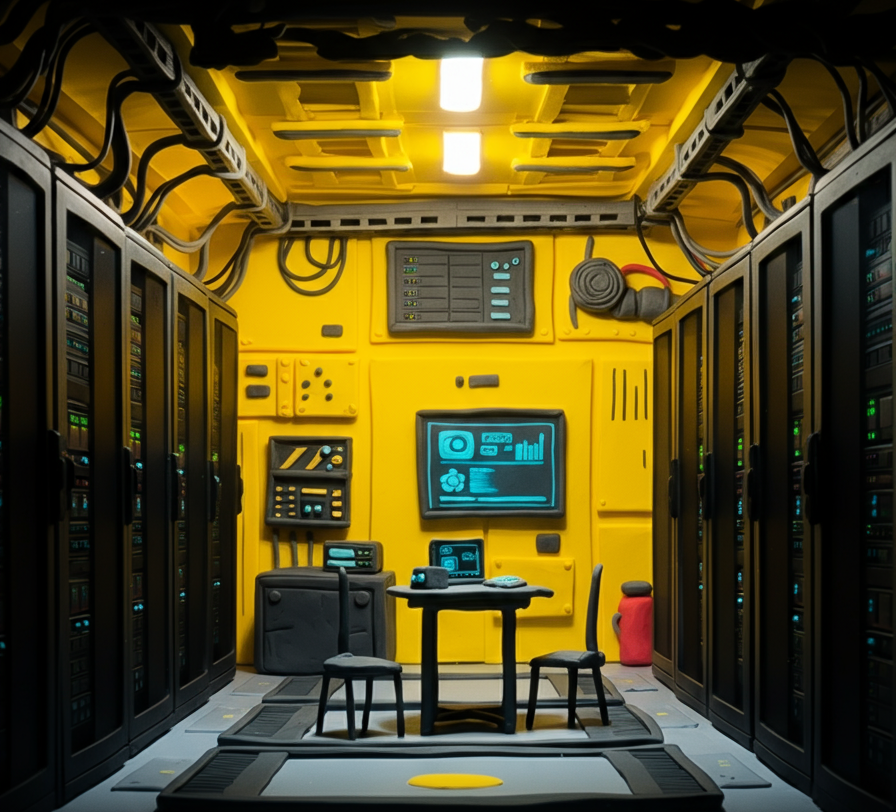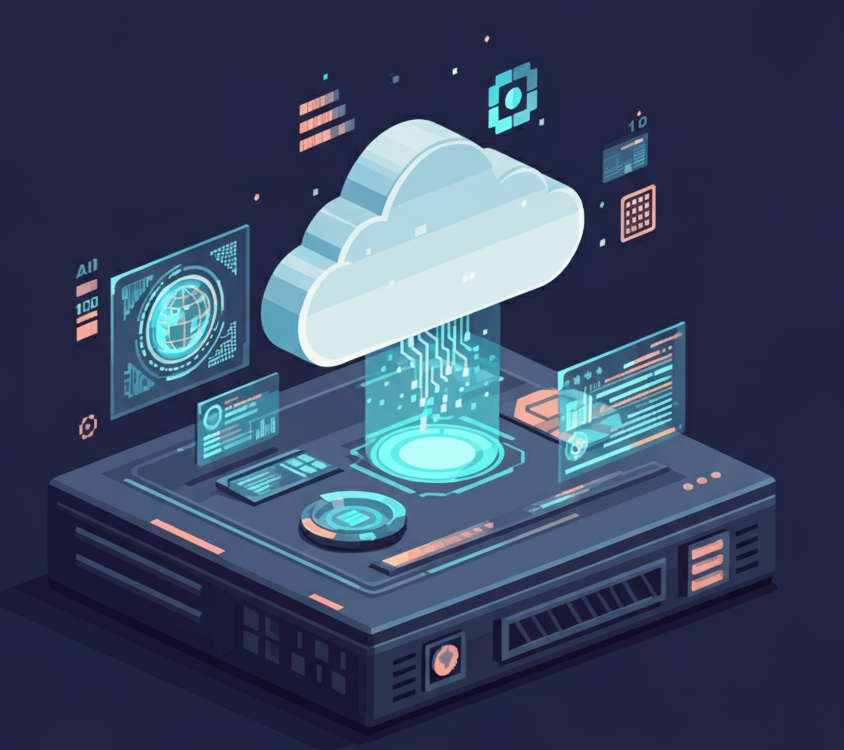The rapid advancements in artificial intelligence (AI) have led to a major question – will the internet eventually be too small for AI?
Understanding AI’s Internet Footprint
Artificial intelligence has become an integral part of our digital landscape. From streaming services to virtual assistants, AI’s presence on the internet is undeniable. But what happens when AI’s demand for data and computational resources outgrows the current infrastructure?

The footprint of AI on the internet is vast and ever-expanding. As of 2021, it was estimated that the AI market was worth $62.35 billion. It is projected to grow at a compound annual growth rate (CAGR) of 40.2% from 2021 to 2028. This rapid growth puts more pressure on internet resources. For instance, training a single AI model, like OpenAI’s GPT-3, can require anywhere from 700 gigabytes to 45 terabytes of data (GPT-4 uses 1 petabyte of data) and significant computational power. Such an appetite implies substantial bandwidth and storage requirements. Furthermore, as AI becomes more embedded in areas such as healthcare, finance, and autonomous driving, the volume of data processed and transmitted over the internet will only increase.
A study by Cisco predicts that by the end of 2023, machine-to-machine (M2M) connections will make up 50% of the total 14.7 billion global networked devices and connections, up from 33% in 2018. This shift towards a more AI-intensive internet ecosystem requires robust upgrades in network infrastructure to prevent bottlenecks and ensure data flows smoothly. As AI applications continue to evolve and integrate deeper into our daily lives, understanding and addressing its internet footprint becomes critical for sustaining future technological growth.
The Expanding Universe of Data in the age of AI
Every day, we generate an astronomical amount of data. According to a recent study, approximately 2.5 quintillion bytes of data are created daily. AI relies on this vast pool of data to learn, adapt, and evolve. IoT devices, smart apps, and autonomous systems will lead to a massive increase in data volume.

To put this into perspective, by 2025, it is estimated that 463 exabytes of data will be created each day globally. This data explosion is fueled by the increasing digitalization of our daily activities, from social media interactions to business transactions. For instance, the average internet user generates approximately 1.7 MB of data every second. Furthermore, over 500 hours of video are uploaded to YouTube every minute, and Google processes over 3.5 billion searches per day.
The vast amount of data coming in creates opportunities and challenges for AI. AI can use this data to enhance accuracy and capabilities. However, dealing with storing and transmitting this data requires a very strong infrastructure. This ongoing process of data and AI progress highlights the need for scalable solutions to manage the growing data universe and keep the internet a viable platform for AI innovations.
AI’s Appetite for Computing Power
AI systems require significant processing power to analyze data, train models, and make decisions. This demand for high-performance computing has led to the development of specialized hardware like GPUs and TPUs. However, as AI becomes more sophisticated, its computational needs will continue to grow.

The increasing complexity of AI models demands not only more data but also exponentially greater computing power. Training state-of-the-art AI models such as deep neural networks involves millions, if not billions, of parameters, which require extensive computational resources. For example, OpenAI’s GPT-3 model boasts 175 billion parameters, requiring powerful GPUs and TPUs to handle the intensive computations efficiently. In addition, GPT-4 boasts over 1.76 trillion parameters, which indicates a need for even more powerful computational power.
To further illustrate this appetite, consider the electricity consumption of AI systems. A study from the University of Massachusetts Amherst found that training a large AI model can emit as much as 284 metric tons of carbon dioxide.This is equivalent to five times the lifetime emissions of an average American car. Furthermore, advancements in AI hardware like NVIDIA’s A100 Tensor Core GPUs are geared towards addressing these computational challenges. Furthermore, this provides performance improvements of up to 20x in certain tasks compared to previous generations.
This need for computing power has also led to the rise of AI-specific data centers. Companies such as Google, Amazon, and Microsoft are investing billions in constructing specialized facilities to support AI research and deployment. For example, Google’s data centers house the company’s custom-designed Tensor Processing Units (TPUs), which are pivotal in powering AI-driven services like Google Search and Google Photos.
As AI continues to push the boundaries of technology, the demand for enhanced computational infrastructure will only grow. Ensuring that this infrastructure evolves in tandem with AI advancements is crucial to maintaining the pace of innovation and addressing the environmental impacts associated with these powerful systems.
Internet Bandwidth and Latency Concerns
One of the primary concerns is whether the current internet infrastructure is able to handle the increasing load. Higher bandwidth and lower latency are essential for real-time AI applications such as autonomous vehicles, telemedicine, and augmented reality. The rollout of 5G technology promises to alleviate some of these issues, but it may not be enough in the long run.

Despite the potential benefits of 5G technology, the current internet infrastructure faces significant challenges in meeting the demands of AI-driven applications. Real-time AI applications like autonomous vehicles require ultra-low latency to make rapid decisions, often within milliseconds. For instance, Intel indicates that autonomous cars generate and process approximately 4 terabytes of data in just 1.5 hours of driving, requiring swift and efficient data transmission.
Moreover, telemedicine applications, which became increasingly vital during the COVID-19 pandemic, depend on seamless video streaming and real-time data exchanges to provide quality healthcare remotely. According to Grand View Research, the global telemedicine market size is expected to reach USD 298.9 billion by 2028. This emphasizes the need for robust internet infrastructure to support these services. Even minor delays or interruptions in data transmission can compromise the effectiveness of AI applications in critical situations.
The growing field of augmented reality (AR) also presents substantial bandwidth and latency challenges. Global AR users expected to reach 1.73 billion by 2024. To boost user experience, networks require significant enhancements. To address these concerns, changes in network architecture are essential. Initiatives like edge computing, where data processing occurs closer to the data source rather than in a centralized data center, can help reduce latency and distribute the computational load.
The Role of Edge Computing in AI world
Edge computing offers a potential solution by processing data closer to the source, reducing the strain on central servers and minimizing latency. By distributing computational tasks, edge computing can help manage the growing demands of AI without overwhelming the internet. This approach not only reduces latency but also enhances security, as data can be processed locally without needing to travel across multiple networks.

A report by Gartner predicts that by 2025, 75% of enterprise-generated data will be created and processed outside traditional centralized data centers or cloud environments. This is up from less than 10% in 2018. This shift highlights the increased significance of edge computing in handling large amounts of data from AI applications.
Moreover, edge computing can significantly reduce bandwidth usage. According to Cisco, global data center traffic has been projected to reach 20.6 zettabytes by the end of 2021, with a substantial portion being attributed to AI and IoT devices. By processing data closer to where it is generated, edge computing can alleviate the burden on central networks, ensuring smoother and more efficient data flows.
Companies are already investing in edge computing to enhance their AI capabilities. For example, IBM has developed its Edge Application Manager, which allows businesses to deploy AI, IoT, and analytics workloads to edge devices efficiently. Similarly, Microsoft’s Azure IoT Edge platform provides tools to run AI and machine learning models directly on edge devices, reducing the need for constant cloud connectivity.
Quantum Computing to the Rescue?
Quantum computing, with its promise of unparalleled processing power, could revolutionize AI. Although still in its infancy, quantum computing has the potential to tackle complex problems that classical computers cannot. This could provide the necessary boost in computational capacity to support AI’s future growth.
However, harnessing the power of quantum computing is no small job. Quantum computers operate on principles of quantum mechanics, using qubits instead of traditional bits. Unlike bits, which are binary, qubits can exist in multiple states simultaneously due to superposition. This characteristic, in tandem with entanglement, enables quantum computers to perform multiple calculations at once, vastly outpacing the capabilities of classical computers in certain scenarios.
The potential impact of quantum computing on AI is huge. For example, quantum computers could significantly expedite the training of complex machine learning models, which currently require vast computational resources and time. According to a report by PWC, quantum computing could reduce the time required to train AI models from months to a matter of seconds, unlocking new possibilities for real-time AI applications.
Moreover, quantum computing might provide innovative solutions to optimisation problems, which are at the heart of many AI applications. From traffic management to supply chain optimization, these problems can be computationally intensive and difficult for classical computers to solve efficiently. A study published in Nature Communications (2021) claims that quantum algorithms could offer exponential speedups for certain types of optimization tasks, potentially transforming industries that rely heavily on AI-driven decision-making.
Investment in quantum computing is rapidly increasing. According to Allied Market Research, the global quantum computing market is projected to reach $64.98 billion by 2030, growing at a compounded annual growth rate (CAGR) of 56.0% from 2021. Leading tech companies, such as IBM, Google, and Microsoft, are making significant efforts in developing quantum hardware and software, aiming to make quantum computing more accessible and practical for real-world applications.
Despite the optimism, significant challenges remain. Quantum computers are highly sensitive to environmental disturbances, and maintaining qubit stability is a major technical hurdle. Furthermore, developing quantum algorithms that can efficiently solve practical problems is still an ongoing area of research. Nonetheless, the rapid advancements and growing investments indicate that quantum computing could soon become a vital component of AI, enabling unprecedented levels of computational performance and innovation.
As quantum computing technology continues to evolve, its integration with AI could lead to breakthroughs that are currently unimaginable with classical computing. Ensuring robust quantum infrastructure and fostering collaboration between AI and quantum research communities will be essential to unlock the full potential of this revolutionary technology.
Conclusion
While it’s unlikely that the internet will become “too small” for AI in the immediate future, this idea warrants consideration and proactive planning. The collaboration between AI developers, network engineers, and policymakers will be essential to ensure that our digital infrastructure can sustain the growing needs of AI.



